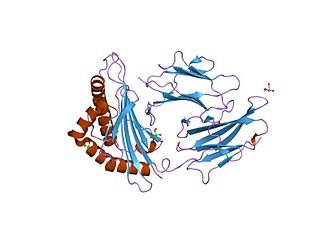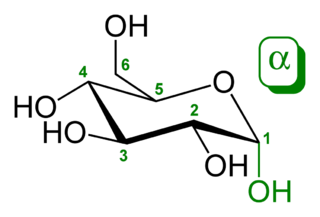
H2 receptors are positively coupled to adenylate cyclase via Gs. It is a potent stimulant of cAMP production, which leads to activation of protein kinase A. PKA functions to phosphorylate certain proteins, affecting their activity. The drug betazole is an example of a histamine H2 receptor agonist.

E-selectin, also known as CD62 antigen-like family member E (CD62E), endothelial-leukocyte adhesion molecule 1 (ELAM-1), or leukocyte-endothelial cell adhesion molecule 2 (LECAM2), is a selectin cell adhesion molecule expressed only on endothelial cells activated by cytokines. Like other selectins, it plays an important part in inflammation. In humans, E-selectin is encoded by the SELE gene.

CD163 is a protein that in humans is encoded by the CD163 gene. CD163 is the high affinity scavenger receptor for the hemoglobin-haptoglobin complex and in the absence of haptoglobin - with lower affinity - for hemoglobin alone. It also is a marker of cells from the monocyte/macrophage lineage. CD163 functions as innate immune sensor for gram-positive and gram-negative bacteria. The receptor was discovered in 1987.

Brain-specific angiogenesis inhibitor 1 is a protein that in humans is encoded by the BAI1 gene. It is a member of the adhesion-GPCR family of receptors.

Chemokine like receptor 1 also known as ChemR23 is a protein that in humans is encoded by the CMKLR1 gene. Chemokine receptor-like 1 is a G protein-coupled receptor for the chemoattractant adipokine chemerin and the omega-3 fatty acid eicosapentaenoic acid-derived specialized pro-resolving molecule, resolvin E1. The murine receptor that shares almost 80% homology with the human receptor, is called Dez.

N-formyl peptide receptor 3 (FPR3) is a receptor protein that in humans is encoded by the FPR3 gene.

Melanocortin receptor 5 is a protein that in humans is encoded by the MC5R gene. It is located on the chromosome 18 in the human genome. When the melanocortin 5 receptor was disrupted in transgenic mice, it induced disruption of their exocrine glands and resulted in decreased production of sebum.

P2Y purinoceptor 6 is a protein that in humans is encoded by the P2RY6 gene.

Vasoactive intestinal polypeptide receptor 1 also known as VPAC1, is a protein, that in humans is encoded by the VIPR1 gene. VPAC1 is expressed in the brain (cerebral cortex, hippocampus, amygdala), lung, prostate, peripheral blood leukocytes, liver, small intestine, heart, spleen, placenta, kidney, thymus and testis.

Peroxiredoxin-1 is a protein that in humans is encoded by the PRDX1 gene.

Homeobox protein Hox-B6 is a protein that in humans is encoded by the HOXB6 gene.

Kv channel-interacting protein 2 also known as KChIP2 is a protein that in humans is encoded by the KCNIP2 gene.

Thioredoxin-interacting protein is a protein that in humans is encoded by the TXNIP gene.

Paired box gene 4, also known as PAX4, is a protein which in humans is encoded by the PAX4 gene.

ATP-binding cassette sub-family A member 7 is a protein that in humans is encoded by the ABCA7 gene.

Zinc finger protein 318 is a protein that in humans is encoded by the ZNF318 gene.

Solute carrier family 2, facilitated glucose transporter member 11 (SLC2A11) also known as glucose transporter type 10/11 (GLUT-10/11) is a protein that in humans is encoded by the SLC2A11 gene.

N-Arachidonylglycine (NAGly) is a carboxylic metabolite of the endocannabinoid anandamide (AEA). Since it was first synthesized in 1996, NAGly has been a primary focus of the relatively contemporary field of lipidomics due to its wide range of signaling targets in the brain, the immune system and throughout various other bodily systems. In combination with 2‐arachidonoyl glycerol (2‐AG), NAGly has enabled the identification of a family of lipids often referred to as endocannabinoids. Recently, NAGly has been found to bind to G-protein coupled receptor 18 (GPR18), the putative abnormal cannabidiol receptor. NaGly is an endogenous inhibitor of fatty acid amide hydrolase (FAAH) and thereby increases the ethanolamide endocannabinoids AEA, oleoylethanolamide (OEA) and palmitoylethanolamide (PEA) levels. NaGly is found throughout the body and research on its explicit functions is ongoing.
Alpha,alpha-trehalose synthase is an enzyme with systematic name ADP-glucose:D-glucose 1-alpha-D-glucosyltransferase. This enzyme catalyses the following chemical reaction

ANGPTL8 is a protein that in humans is encoded by the C19orf80 gene.

















